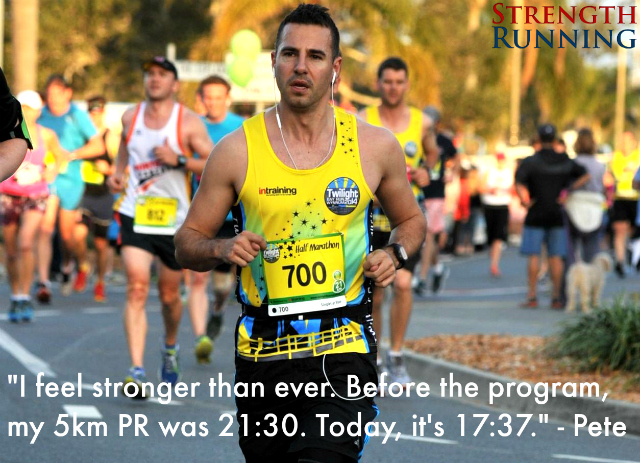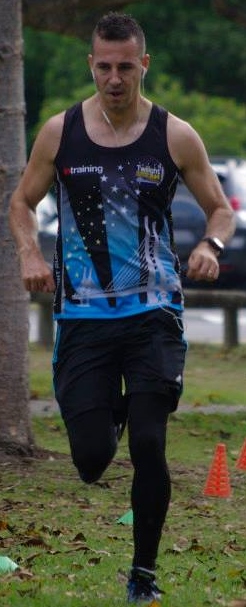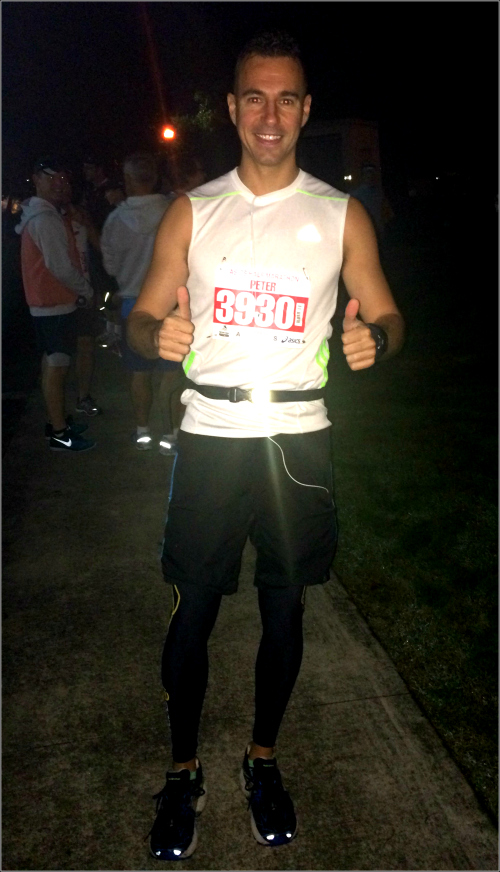Today, I want you to meet Pete, a relatively new runner who improved his 5k from 21:30 to 17:37. Crazy, right?

This is one of the most inspiring success stories I’ve ever seen because Pete overcame so many challenges:
- He suffered severe IT Band Syndrome within just a few months of starting to run
- His physiotherapist told him he wasn’t “cut out for running”
- Pete’s ITBS lasted a month (then he finally realized that rest doesn’t help recovery)
- The injury rattled his confidence, leaving him afraid it would come back whenever he ran faster or went for a long run
- He was convinced nothing could help him
But after all these obstacles, Pete is now running strong. He’s set a monster personal best in the 5k and his ITBS worries are far behind him thanks to the Injury Prevention for Runners program.
I had to share this story because of how powerful it is – not just for Pete and the results he’s seeing, but for you.
Are you struggling with an injury? Do you want to know how to cure IT Band Syndrome? Have you ever been told that running might not be good for you?
Maybe you’re constantly afraid of aggravating an old injury or convinced you’re doomed, destined to stay injured because nothing can help you get healthy.
Well, I won’t stand for that. I refuse to allow you to stay injured.
Be like Pete: Grab your injury by the neck, show it who’s boss, and wrestle recovery and health from its evil clutches. That’s exactly what Pete did earlier this year – and he’s reaping the rewards.
But I’ll be honest – I get emails all the time from frustrated runners who have an injury that I know exactly how to fix. But they never follow through. They never commit and take action to improve.
And sometimes, I’ll get ANOTHER email weeks or even months later… and these runners are still injured.
Just the other day a runner told me she was DYING to heal her Achilles Tendinopathy. When I told her what to do, she didn’t do it!
Can you imagine how frustrating that is to a coach? Believe me, it drives me nuts.
But Pete was different. He followed a proven plan. He was disciplined. And now he’s the latest Strength Running success story because he followed through.
If you’re struggling right now, I hope you follow through and commit to getting healthy. It’s well worth it, as you’ll see from Pete’s story.
Pete Gets Bit by the Running Bug… Hard
For some, running grows on us gradually. We make a resolution to get healthy or have a friend rope us into our first race and our love for running creeps up on us gradually. But soon we realize just how essential a part of our lives it has become.
But Pete was smitten by running as soon as he started. Unfortunately, this unbridled enthusiasm caused a painful case of ITBS that completely sidelined his running. He told me:
Unfortunately, I got a nasty case of ITBS within months of my ambitious and belated attempt to challenge Kenya’s greatest marathoners. One day during an 18km easy run I felt a stabbing pain in the side of my right knee. I also felt terrible stiffness. I thought I had the onset of early arthritis. I saw a physio who diagnosed me with ITBS and an MRI confirmed it had reached the ‘severe’ stage.
After years of working at a desk job, Pete’s body was unprepared to handle his new love for running. As with many new runners, his training lacked a proven, comprehensive foundation that would help his running progress injury free.
And as much as he wanted to run, his body told him in no uncertain terms that it needed a little assistance.
My body certainly wasn’t conditioned to the stresses distance running imposed after working in a desk job for more than a decade. Everything seemed to hurt at some point. My ankles, my feet, my hips, my back and, most of all, my right knee.
When Pete sought out help with his injury, his doctor was not helpful. Like many non-runners, the doc simply told him that perhaps he just wasn’t cut out for running and didn’t even suggest any rehabilitation plan.
Pro tip: if your doctor isn’t also a runner, don’t talk to her about your running injuries.
Fortunately, Pete was resilient and resourceful. He took it upon himself to seek out more informed, useful advice.
After a month of futile waiting for the injury to settle, I decided I would leave no stone unturned if I wanted to get serious about running, and doing so injury-free. After reading Jason’s struggle with ITBS, I believed his insights and advice could expedite my recovery.
Coming back from injury is never easy. It requires a commitment and a willingness to try new things and change old habits. After all, if you keep doing what you’re doing, you’ll keep getting what you’ve always gotten.
But trying new things isn’t enough. You have to do the right things. Pete was ready to do the work he needed to get healthy and make running a regular part of his life.
How Pete Cured IT Band Syndrome
Despite his work ethic, Pete’s road to recovery had its share of challenges. The road to healthy running can be bumpy, and in Pete’s case he was afraid of reinjuring his knee and aggravating his ITBS injury.
But soon, he started experiencing real, tangible results:
When I returned to running, I initially struggled to enjoy it. It was replaced by a fear that pain and stiffness in my knee was only a mile away.
But with each tentative run, I built confidence. Every run without a tweak or twinge helped me exorcise the demons.
Pete was a new runner – pain-free and getting faster by the week. More importantly, the changes to his training were simple and effective and he could maintain them even with a family and other responsibilities.
Jason’s insights are easy to digest and implement. Many of the exercises prescribed can be done easily in a short time frame. I lead a busy life with kids, work and travel and have little trouble fitting them in every day.
Pete learned a lot about what it takes to run healthy by applying the six principles of prevention included in Injury Prevention for Runners. He credits the program with giving him a better understanding how certain weaknesses can cause injuries.
After learning the hard way that it’s probably not the best idea to jump into a half marathon a mere 2 weeks after his first 10k, he is now more cautious about increasing his mileage too dramatically. He has also discovered that rest and diet can play as important a role as the training itself.
Pete told me:
I’ve learned in running, like so many other facets of life, that you reap what you sow. New runners can get seduced by it and feel invincible, but in my case my body wasn’t ready to cope with too many miles too quickly. I now listen to my body better and force myself to take a day off if required.
Now that he has recovered, Pete is back on track and running stronger than ever. He’s made enormous progress in his strength and speed while staying healthy and injury free. Aches and pains from years of desk work have even improved as Pete continues to follow the principles of the program and implement strength routines on a regular basis.
Jason’s injury prevention program has had a marked impact on my body and, in turn, my running. My knee feels great and the back pain I experienced for 20 years is gone.
I feel more flexible and stronger than ever. Before the program, my 5km PR was 21.30. Today, it is 17.37 and I hope to get faster and ultimately run a marathon.
Pete’s passion for running and racing is followed closely by his enthusiasm for the program that got him healthy. I asked him what benefits he experienced with Injury Prevention for Runners and he told me:
The top three positive results are: you will run better. You will run smarter. You will learn how to run injury-free.
Succinct and to the point. I love it!
Why Was Pete so Successful?
Pete overcame the odds and got healthy from a potentially debilitating injury for a variety of reasons. But most importantly:
1. He was willing to try something new. Instead of saying something counter-productive like, “I’ll just rest for another few weeks and figure this out on my own” Pete realized he needed a  fresh approach.
fresh approach.
It’s too easy to get into a slump when you experience an injury, wallowing in self pity and spending months on the couch shoving ice cream in your face (like I did with my IT band injury in 2009).
But those that get healthy attack their injury with a vengeance and leave no stone unturned.
2. Pete did the RIGHT strength work. Unlike the “take a bunch of random classes at the gym” approach (or my all-time favorite, following a nonsense workout from a fitness magazine), Pete realized he needed exercises that were runner-specific.
When runners suffer from a running injury, they need a treatment protocol designed for runners. Sounds like common sense, right? But as you can see from his doctor’s reply of “maybe you’re not cut out for running!” it helps to get advice from a coach or doctor who’s also a runner.
The treatment protocol included in Injury Prevention for Runners is comprehensive in that it includes a variety of strategies:
- A thorough description of the injury and WHY it occurs, so we can better understand the treatment approach
- Myths about the injury so we don’t focus on doing the wrong things
- Specific workouts and strength routines (like an updated ITB Rehab Routine and the Stiletto Routine)
- The most common questions about ITBS answered about knee straps, whether an MRI is necessary, and if you can run through the injury
- Form cues that help prevent ITB pain from recurring
- Advice on how your running should change after ITBS to prevent it from happening again.
Unlike a “3 best exercises for ITBS” article, this goes way deeper. And it’s the reason why the program has been enormously successful – not just for those with ITBS, but also plantar fasciitis, runner’s knee, and Achilles tendinopathy.
3. Pete had a plan. Injury Prevention for Runners’ includes a treatment protocol with daily treatment strategies, including “recovery workouts,” and what to do while you’re hurt and once you get healthy.
Pete stayed consistent with his treatment and stuck to the program, instead of bouncing around from one plan to the next. He was successful because he actually followed through with it!
He didn’t give up, try the latest fad, or chase any shiny red balls in other directions. He didn’t expect results overnight – because as we all know, there are no secrets or magic workouts. There’s just the best, most thorough approach available.
I’m thrilled to share Pete’s success with you because it shows what’s possible when you put your head down and get to work. Even with a family, job, travel, and kids he was able to get healthy in record time and improve his 5k time by nearly 4 minutes. FOUR MINUTES! Crazy.
If you suffer from an injury, I know Injury Prevention for Runners can help you get (and stay) healthy. Give it a shot. Who knows, you might just be our next big success story.
***
UPDATE! About two months after this article was published, Pete emailed me. Below is a copy of the text he sent.
Hi Jason,
Hope you are well mate and your running is going well. I thought I would get in touch with you to give you an update on my progress.
I ran the Gold Coast half marathon today and finished in 1hr 28min. Last September, I did my first ever half marathon in 1.45, so I’ve smashed my PB in this event by 17 minutes!!
As you can imagine, I’m truly ecstatic and proud that all the hard work I’ve put in on my body in the past year has paid dividends. 
I would again like to thank you for your program and hope this is another example for your readers that major gains can be attained through diligence, commitment and hard work.
Your program is a major plank in my daily running. I perform your exercises religiously, every day and I believe it’s the reason I’ve improved so rapidly.
I spent four months training for Gold Coast and, apart from the odd tight hammy or sore calf, did not have a significant injury which stopped my running.
Your exercises are an outstanding bedrock for anyone looking to get better as a runner.
My ITB issues are a thing of the past, I don’t even give it a second thought now because I have total confidence in the hip, VMO and glute strength I have built following your program.
I will attach a photo I took this morning before the race, please feel free to use it. I hope your readers get the same benefits out of your brilliant program that I have.
I plan to do my first marathon next year and one day hope to crack the sub-3 barrier. Thanks again.
Cheers mate.